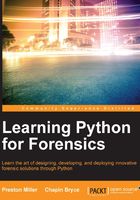
Chapter 2. Python Fundamentals
We have explored the basic concepts behind Python and the fundamental elements used to construct scripts. We will now build a series of scripts throughout this book using the data types and built-in functions we've discussed in the first chapter. Before we begin developing scripts, let's walk through more important features of the Python language, building upon our existing knowledge.
In this chapter, we will explore more advanced features that we will utilize when building our Python forensic scripts. This includes more advanced data types and functions, creating our first script, handling errors, using libraries, interacting with the user, and best practices for development. After completing this chapter, we will be ready to dive into real-world examples featuring the utility of Python in forensic case work.
This chapter will cover the following topics:
- Advanced features including iterators and
datetimeobjects - Installing and using modules
- Error handling with try, except, and raise statements
- Sanity-checking and accessing user-supplied data
- Creating forensic scripts to find USB vendor and product information